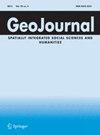International environmental policy processes that dispossessed developing societies of public land resources: A case study of Nepal
IF 1.9
Q2 GEOGRAPHY
引用次数: 0
Abstract
Abstract Public lands including forests and community pastures are still crucial means of local livelihood, social security, and environmental conservation in many developing countries including Nepal. However, these resources are increasingly managed primarily to offset greenhouse gas emissions of developed countries. The new management has exacerbated many local problems: livelihood constriction, social crises, human casualties (deaths and serious injuries), biodiversity degradation, and water scarcity including cryosphere retreating. Drawing data from multiple sources, this study attempted to explain the international political objectives and processes that dispossessed developing societies of public land resources for the benefit of developed countries. It shows that representatives of the developed countries were proactively and strategically involved in agenda formation, solutions negotiations, and decision-making while developing international environmental policies, and succeeded to structure the policies for managing the resources of developing countries for the best benefit of their own countries. The developed countries provided funds and experts, as strategic tools, through international aid agencies to implement the policies of their interest in institutionally weak countries. In Nepal, the aid agencies influenced the thinking of the public and the decisions of the government and other stakeholders through a series of strategic measures. They propagandized false crises, worked with a coalition of powerful international agencies, offered free technical support, and changed national policies proactively to manage the land resources for achieving their missions. Active involvement in policy implementation also helped the agencies to monitor implementation hurdles and apply other tactics to resolve them. Lucrative flash incentives were provided to motivate and get the support of communities, powerful stakeholders, and politicians to implement the policies. Psychosocial pressures were also applied to persuade local communities and their leaders for getting local cooperation in making and practicing new legal institutions (government authority rules or orders, user group rules, and forest management plans) that bind and control local communities for forest protection. The institutions obliged local communities to contribute free labor or cash for developing, modifying, and protecting the forests. These two levels of interventions led to the further development of reinforcing institutions, resource conditions, and social-ecological systems that secured benefits for developed countries and deprived local communities of power to control, produce and access the public land resources in their own backyard for years. This study also showed that international environmental policies and aid agencies have respectively served as institutional weapons and vehicles for materially and institutionally powerful countries to colonize the land resources of weaker countries, without using of physical coercion or deplyment of military forces.剥夺发展中社会公共土地资源的国际环境政策进程:尼泊尔个案研究
在包括尼泊尔在内的许多发展中国家,包括森林和社区牧场在内的公共土地仍然是当地生计、社会保障和环境保护的重要手段。然而,这些资源的管理越来越多地主要用于抵消发达国家的温室气体排放。新的管理加剧了许多地方问题:生计紧缩、社会危机、人员伤亡(死亡和重伤)、生物多样性退化以及包括冰冻圈退缩在内的水资源短缺。本研究利用多种来源的数据,试图解释为了发达国家的利益而剥夺发展中社会公共土地资源的国际政治目标和过程。这表明,发达国家的代表在制定国际环境政策的同时,积极地、战略性地参与议程的形成、解决方案的谈判和决策,并成功地构建了管理发展中国家资源的政策,以使其本国获得最大利益。发达国家通过国际援助机构提供资金和专家,作为战略工具,在体制薄弱的国家执行符合它们利益的政策。在尼泊尔,援助机构通过一系列战略措施影响了公众的思想以及政府和其他利益攸关方的决策。他们宣传虚假的危机,与强大的国际机构联盟合作,提供免费的技术支持,并主动改变国家政策,以管理土地资源以实现其使命。积极参与政策执行也有助于各机构监测执行障碍并采用其他策略来解决这些障碍。为了激励和获得社区、强大的利益相关者和政治家的支持来实施这些政策,政府提供了丰厚的短期激励措施。还施加了社会心理压力,说服当地社区及其领导人在制定和实施新的法律制度(政府当局规则或命令、用户群体规则和森林管理计划)方面获得当地合作,约束和控制当地社区保护森林。这些机构要求当地社区为开发、改造和保护森林提供免费的劳动力或现金。这两个层面的干预导致了强化制度、资源条件和社会生态系统的进一步发展,这些制度确保了发达国家的利益,并剥夺了当地社区多年来控制、生产和获取自家后院公共土地资源的权力。这项研究还表明,国际环境政策和援助机构分别成为物质强国和制度强国在不使用武力胁迫或部署军事力量的情况下殖民弱小国家土地资源的制度武器和工具。
本文章由计算机程序翻译,如有差异,请以英文原文为准。
求助全文
约1分钟内获得全文
求助全文
来源期刊

GEOJOURNAL
GEOGRAPHY-
CiteScore
4.90
自引率
7.40%
发文量
228
期刊介绍:
Aims & ScopeGeoJournal is an international journal devoted to all branches of spatially integrated social sciences and humanities. This long standing journal is committed to publishing cutting-edge, innovative, original and timely research from around the world and across the whole spectrum of social sciences and humanities that have an explicit geographical/spatial component, in particular in GeoJournal’s six major areas:- Economic and Development Geography- Social and Political Geography- Cultural and Historical Geography- Health and Medical Geography- Environmental Geography and Sustainable Development - Legal/Ethical Geography and Policy
In addition to research papers GeoJournal publishes reviews as well as shorter articles in the form of research notes, commentaries, and reports. Submissions should demonstrate original and substantive contributions to social science and humanities from a geographical perspective. Submissions on emerging new fields such as GeoEthics, Neogeography, Digital Humanities and other emerging topics are also welcome.
GeoJournal’s focus makes the journal essential reading for human geographers working in these areas, as well as for researchers from other disciplines, such as sociology, economics, political science, demography, environmental studies, urban planning, history, and cultural studies.
Last but not least, GeoJournal encourages feedbacks and discussions on articles published in the journal through letters to the editor.
GeoJournal is published bi-monthly in February, April, June, August, October and December.
 求助内容:
求助内容: 应助结果提醒方式:
应助结果提醒方式:


